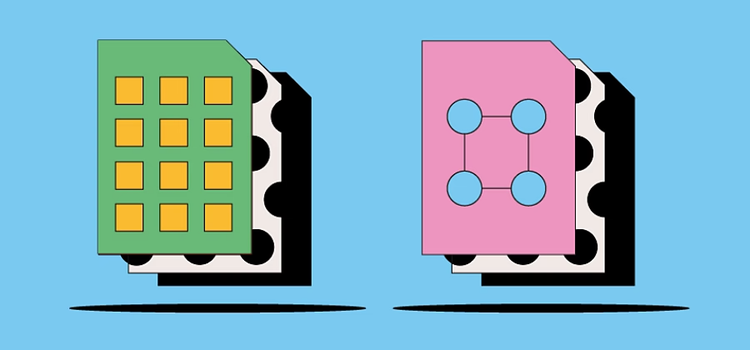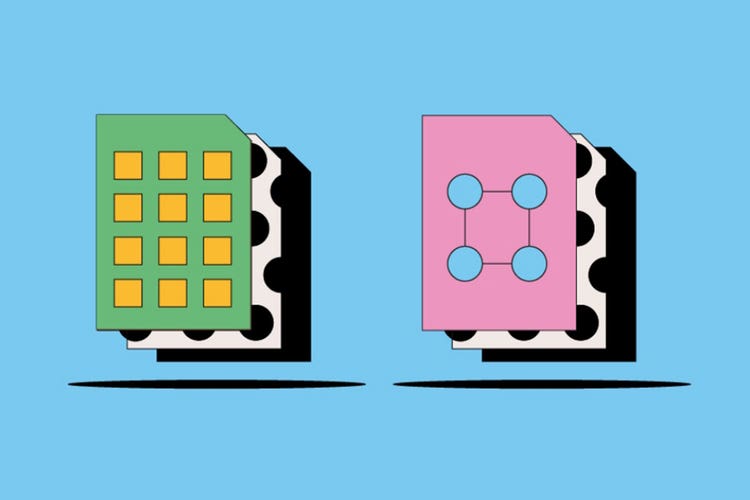PHOTOGRAPHY
Raster vs Vector.
When working with digital photos, graphic design, logos, and other digital images, raster and vector are the two most common file types you’ll encounter. Learn about the key features, similarities, and differences between the two to decide when and where to use each.

https://main--cc--adobecom.hlx.page/cc-shared/fragments/seo-articles/get-started-notification-blade
What is a raster file?
Raster files are images built from pixels — tiny color squares that, in great quantity, can form highly detailed images such as photographs. The more pixels an image has, the higher quality it will be, and vice versa. The number of pixels in an image depends on the file type (for example, JPEG, GIF, or PNG).
What is a vector file?
Vector files use mathematical equations, lines, and curves with fixed points on a grid to produce an image. There are no pixels in a vector file. A vector file’s mathematical formulas capture shape, border, and fill color to build an image. Because the mathematical formula recalibrates to any size, you can scale a vector image up or down without impacting its quality.
What is the difference between raster and vector files?
Raster and vector files are the two most popular formats used for visual content. They represent images in very different ways, so there’s a lot to consider when deciding which one to use. Some of the main differences between raster and vector include:
Resolution.
One of the main differences between raster and vector files is their resolution. The resolution of a raster file is referred to in DPI (dots per inch) or PPI (pixels per inch). If you zoom in or expand the size of a raster image, you start to see the individual pixels.
Raster files display a wider array of colors, permit greater color editing, and show finer light and shading than vectors — but they lose image quality when resized. An easy way to tell if an image is raster or vector is to increase its size. If the image becomes blurred or pixelated, it’s most likely a raster file.
With vector image files, resolution is not an issue. You can resize, rescale, and reshape vectors infinitely without losing any image quality. Vector files are popular for images that need to appear in a wide variety of sizes, like a logo that needs to fit on both a business card and a billboard.
Uses.
Digital photographs are usually raster files. Many digital cameras automatically shoot and save photos as raster files — and the images you see online are often rasters, too. Raster files are also commonly used for editing images, photos, and graphics.
Vector files work better for digital illustrations, complex graphics, and logos. That’s because the resolution of vectors remains the same when resized, making them suitable for a wide variety of printed formats.
Some projects combine both raster and vector images. For example, a brochure may use vector graphics for the company logo but raster files for photography.
File sizes.
Raster files are generally larger than vector files. They can contain millions of pixels and incredibly high levels of detail. Their large size can impact device storage space and slow down page loading speeds on the web. However, you can compress raster files for storage and web optimization to make sharing faster and easier.
Vector files are much more lightweight than raster files, containing only the mathematical formulas that determine the design.
Compatibility and conversion.
You can open raster files in many different apps and web browsers, making them easy to view, edit, and share. Vector files aren’t as accessible — many vector file types require specialized software to open and edit the files. Though it can present some challenges, it’s possible to convert vector files to raster or raster files to vector when needed.
File and extension types.
Your software will usually determine your file type, whether it’s raster or vector. There are multiple types and extensions of both raster and vector files, each with its own features. Learn more about some of the common ones:
Raster vs. vector files: frequently asked questions.
Is a PDF a raster or vector?
Can you turn a JPEG into a vector file?
You can use Adobe Illustrator to convert a JPEG into a vector:
- Open your JPEG image in Adobe Illustrator.
- Select the JPEG, and in the top bar, click Image Trace.
- Then select Expand to convert into a vector image.
- You can right-click and choose Ungroup to separate the new vector image from its background if desired.
- Edit the image, save, and export it as a vector file.
Is Photoshop vector-based?
No, Adobe Photoshop is a raster-based program, meaning it uses pixels to create detailed images. One of the primary uses of Photoshop is with digital photos, which are usually raster files. But, you can open and edit vector files in Photoshop — either as a smart object or rasterized file.
Is Illustrator raster or vector?
Adobe Illustrator is a vector-based program. While Photoshop excels as a photo editor and graphic design program, Illustrator specializes in creating scalable vector graphics, logos, and design elements. You can open raster files in Illustrator and use the Image Trace tool to turn the image into a vector.
